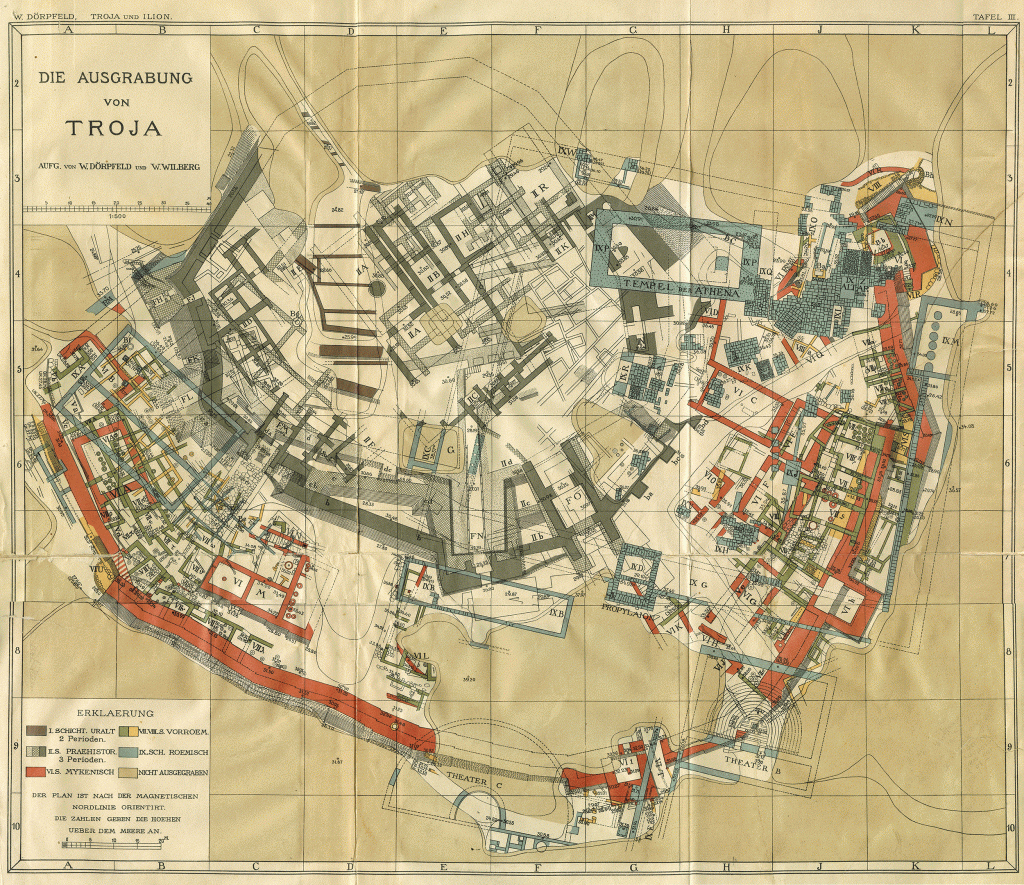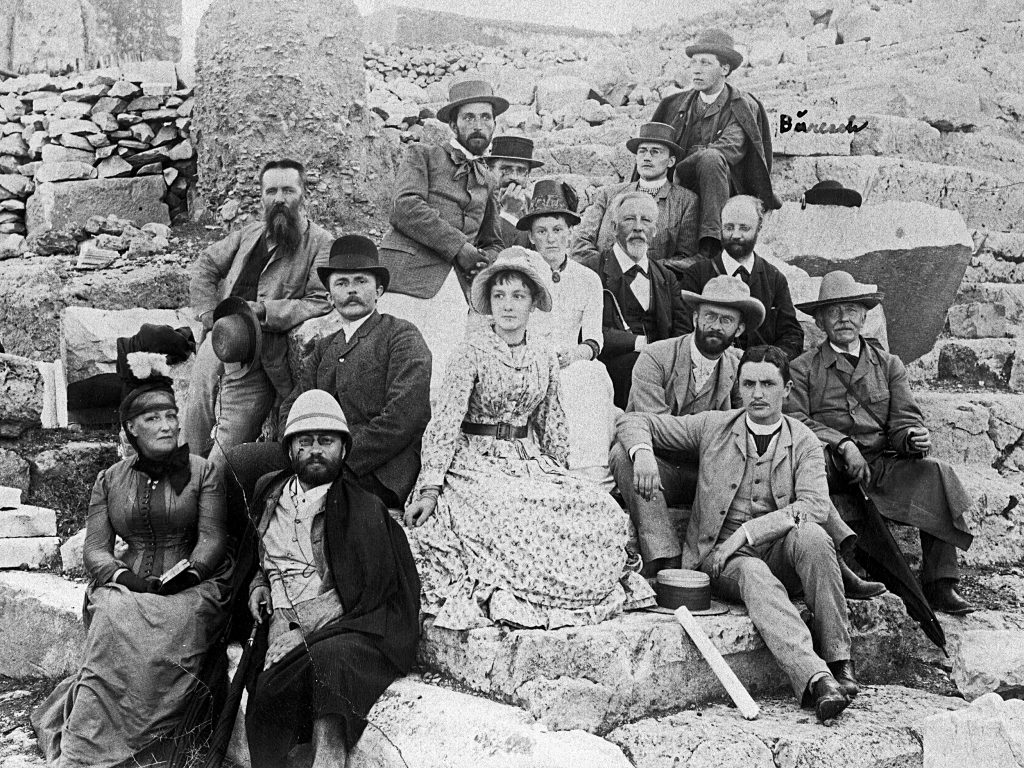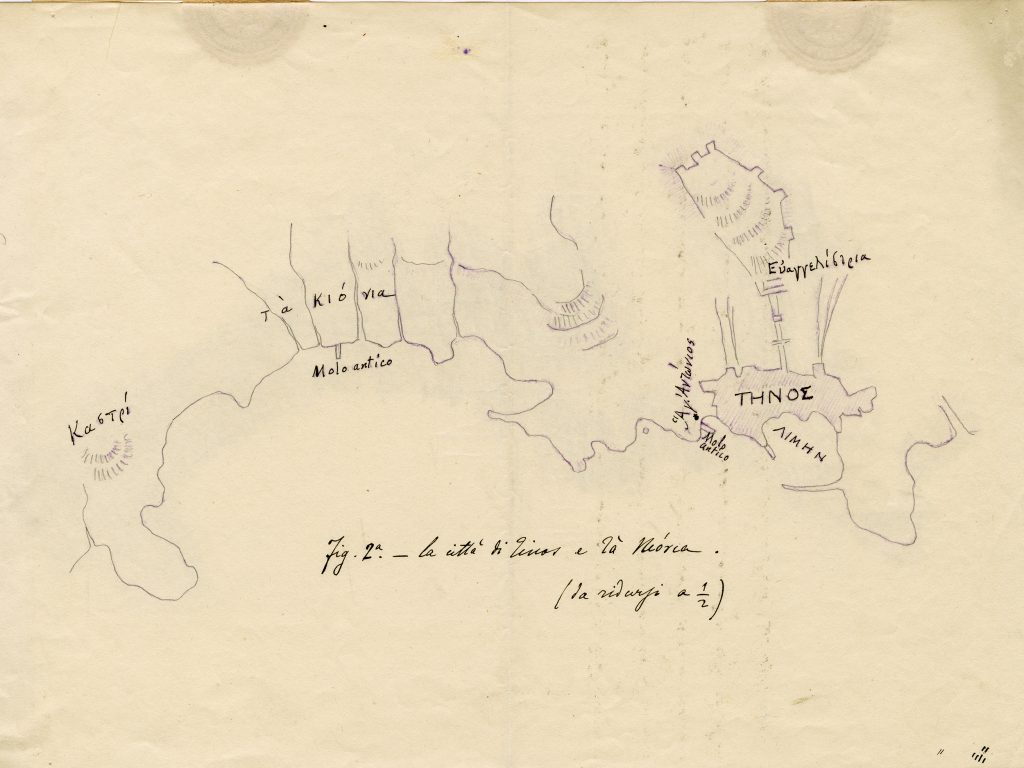Several members of the Wilberg family have been closely connected to the DAI Athens since its establishment in 1874, especially Karl Wilberg, an Athenian bookseller and consul, and his son, Wilhelm, who served as Wilhelm Dörpfeld’s assistant on excavations.
This entry was prompted by the recent publication of the book ›Bauzeichnung und Rekonstruktion. Der Bauforscher Wilhelm Wilberg und die Archäologie um 1900‹. In it, Thea and Peter Vignau-Wilberg outline the life of the building archeologist Wilhelm Wilberg, which has hitherto not received adequate scholarly attention. Wilberg’s career was closely intertwined with the scholarly endeavors of the DAI Athens and the Austrian Archaeological Institute in Athens (ÖAI). With the help of this new publication, a variety of archival materials concerning Wilhelm Wilberg and his family from the holdings of the DAI Athens can now be integrated into this detailed context, and pictures that have now been identified illustrate his time at the department.

Wilhelm’s father, Karl Wilberg (nephew of the famous Karl Baedeker) came to Athens in 1857, long before the establishment of the branch, and had made it his home (Vignau-Wilberg 2022, 14–23) even before the first two DAI travel scholarship recipients – Alexander Conze and Adolf Michaelis – came to Greece in 1860 (Errington 2015). The friendly ties between Karl Wilberg and young scholars in Athens are illustrated not only by the »Familiencirculare« (“family circular letters”) that Michaelis sent home from the Greek capital during his stay (von Steuben 2004, 12. 19-24. 59. 67. 71. 93) but also later on, by the greetings to Wilberg expressed by many correspondents of Ulrich Köhler, Head of the Athens department of the DAI.

When the first scholarly publication of the department appeared, the journal »Athenische Mittheilungen«, in which the latest results on Greek archaeology were published, Karl Wilberg became a regular reference point for the branch. Volume 1 (1876) through volume 10 (1885) all were published »In Commission bei Karl Wilberg« (»by Karl Wilberg«), as printed on the title page of each copy (for example, https://digi.ub.uni-heidelberg.de/diglit/am1876/0007/image,info) and volumes 11 (1886) through 20 (1895) were published by the »Verlag von Karl Wilberg« (»Karl Wilberg Press«). Since many acquisitions for the institute`s library were purchased through his publishing house, the name Wilberg recurs throughout its early records. After Karl Wilberg died in 1882, his sons, who had been tutored by the young archaeologist Habbo G. Lolling from 1872 to 1876, managed the family business for another twelve years. They joined Athenian society as young men and thus also were in touch with the Institute, as attested by entries in the guestbook kept by Wilhelm Dörpfeld and his wife Anne for people invited to their official residence in Fidiou street. The guests present at Dörpfeld’s birthday party on December 26, 1889, included Wilhelm’s mother, Antonie (née von Poyda), and three of his siblings, Marianne, Fritz, and Karl. A few years later, in 1897, Fritz worked as well at the inventory for the Athenian Vases project, as in the Institute’s library for a time – probably after the bookstore was closed (cf. Vignau-Wilberg 2022, 28 n. 71). Different family members were regular guests at the official residence; Wilhelm himself for the first time in 1891, and his brother Paul signed the guestbook in 1893, for example.

Wilhelm Wilberg’s first contact with the DAI Athens
Sometime around 1893, the youngest son of the family, Wilhelm, who had received training in architectural drawing in Ernst Ziller’s famous architectural office (Vignau-Wilberg 2022, 29 f.), appears on the scene at the DAI Athens. On one of his first jobs, Dörpfeld took him along to Troy (Hisarlik) in 1893 and 1894, where Wilhelm supported the renowned building archaeologist by measuring, recording structures, and documenting the ground plans (Dörpfeld 1902, VII–VIII). Most of the drawings that were reproduced in the volume for the excavation published in 1902 thus are probably Wilberg’s work. The master plans with building phases marked in color are especially impressive (fig. 4).

In addition to the well-known image, »Schliemannopolis« (Vignau-Wilberg 2022, fig. 7; Schauer 2020, fig. 7), several other pictures illustrate his time at the legendary excavation site (figs. 5. 6; Fohgrub 2017, 18 fig. 1).


During a brief research trip that brought the academic members of the Troy team of 1893 to Neandria, ten photographs were taken that are now kept in the photograph collection in the DAI Athens. They document the fortifications in particular, but Wilberg and other participants appear on them several times (Fig. 7 and D-DAI-ATH-Neandria-0001).

Family members also evidently came to Troy to visit. A recently attributed photograph shows Wilhelm’s mother, Antonie, and perhaps his sister Marianne, who married the archaeologist Eugen Pridik in 1897, in the middle of a group of visitors to Troy (Hedderich – Weidhaas-Berghöfer 2021, 22. 100) (fig. 8). The picture was presumably taken in 1894, for which Anne Dörpfeld’s presence in Troy is attested (Goebel – Giannopoulou 2010, 45). She is sitting in the middle of the picture.

Various sources inform us about the tasks that young Wilhelm carried out for the Institute. The ›Inventar der Zeichnungen‹ (›Inventory of Drawings‹), that is, the list of drawings prepared for the Institute, many of which were subsequently printed in ›Athenische Mitteilungen‹, names a series of archived drawings he personally prepared that remain in the collection today. In the period 1893–1896, he not only redrew for publication sketches and plans that had been made by other researchers (e.g., plans of the theater in Magnesia, the sanctuary of the Kabirion in Thebes, Arkonnessos at Halicarnassus), but also increasingly drafted plans of his own. The holdings in the archive give an impressive example of how such redrawings were made. When an Italian colleague, Giovanni Patroni, submitted a draft plan of an overview for his essay »Sulle antichità di Tinos« (fig. 9), Wilberg prepared it for publication (fig. 10) so that it could be reproduced in AM 20, 1895 on p. 401, fig. 2.


Thus sometimes, the ›Inventory of Drawings‹ informs us of Wilberg’s authorship, even if this is not mentioned in the publication itself. The name of the illustrator is not (as often at the time) named either on the map of Tinos shown above or on a map of the famous grave mound of Marathon in an article by Valerios Stais in AM 18, 1893, 49.

In addition to the major projects mentioned by Vignau-Wilberg, such as his collaboration on Dörpfeld’s theater book, Theodor Wiegand’s publication on the poros architecture of the Athenian Acropolis, and collaboration on Thera with Friedrich Hiller von Gaertringen (Vignau-Wilberg 2022, 29–32. 45–49. 56f.), Wilberg was also significantly involved in a more autonomous capacity in various projects in the vicinity of the DAI Athens, such as the west slope of the Acropolis under Dörpfeld’s direction, and further afield, such as the exploration of Oche in Euboea with Hans Schrader and Theodor Wiegand. Wilberg’s relationship with Wiegand paved the way for this employment in Priene (Vignau-Wilberg 2022, 58–62). Wiegand explicitly mentions Wilberg’s participation in the study of Oche (Wiegand 1896, 12–13); we cannot determine the precise extent to which he was involved in recording the excavation on the west slope because the overview map is signed as produced by Dörpfeld and Wilberg (Dörpfeld 1895, plate IV), but it may have constantly increased (Körte 1896, 288 with plate XI).
This impression is confirmed by another photograph that captures Wilberg working at the excavation on the west slope of the Acropolis (fig. 12).

Wilhelm Wilberg’ s career as building archaeologist
After this period, Wilberg’s career took him to the Austrian Archaeological Institute in Athens, as the Vignau-Wilbergs vividly illustrate in their volume with an abundance of documents. Shortly after he was appointed the institute’s architect in residence, he was elected a corresponding member of the DAI in 1900. After his election as First Secretary of the ÖAI Athens in 1912, Ordinary Membership in the DAI was conferred on him in 1913. The young assistant of the famous Wilhelm Dörpfeld had become a building archaeologist in his own right, with a considerable scholarly oeuvre, especially in Ephesos (Schauer 1998, 48–50, Vignau-Wilberg 2022, 63–93). In the winter of 1912/1913, he came in touch with the DAI Athens once again, indeed following in the footsteps of his erstwhile teacher Dörpfeld when he retired. He gave architectural tours of the monuments of the ancient city, especially on the Acropolis, in the theater of Dionysos, and the Dipylon, for junior scholars as Georg Karo, now the First Secretary in the department reported in his annual report to the Executive Committee of the DAI in Berlin (Annual report 1912/13 submitted to the Centraldirektion (Executive Committee), DAI Athens, Archiv AR_B-AT-1-26-005). Wilberg had taken part in such on-sight tours conducted by Dörpfeld as an auditor and student with his friend the American archaeologist Nelly Reed in 1895/1896 (Vignau-Wilberg 2022, 35–41, Vogeikoff-Brogan 2019, 256–259). He maintained friendly ties to the DAI Athens for years, as numerous letters (some of them, very personal) from Wilberg to Karo from the years 1914–1915 demonstrate.
Works cited
Dörpfeld 1895
W. Dörpfeld, Die Ausgrabungen am Westanhange der Akropolis. II. Das Lenaion oder Dionysion in den Limnai, AM 20, 1895, 161–206
Dörpfeld 1902
W. Dörpfeld, Troja und Ilion. Ergebnisse der Ausgrabungen in den vorhistorischen und historischen Schichten von Ilion 1870–1894 (Athens 1902)
Errington 2015
L. Errington, Die Berichte der ersten Reisestipendiaten des DAI – zwei Funde im Preußischen Staatsarchiv, JdI 130, 2015, 241–258
Fohgrub 2017
A. Fohgrub, Der erste Fotograf – Rudolf Rohrer, AtheNea 2012, 16–19
Goebel – Giannopoulou 2010
K. Goebel – Ch. Giannopoulou (eds.), Wilhelm Dörpfeld – Daten meines Lebens (Patras 2010)
Hedderich – Weidhaas-Berghöfer 2021
G. Hedderich – M. Weidhaas-Berghöfer (eds.), Wilhelm Dörpfeld – Meiner lieben Schwester Christine – Impressionen eines weitgereisten Archäologen (Wuppertal 2021)
Körte 1896
A. Körte, Die Ausgrabungen am Westabhange der Akropolis IV. Das Heiligtum des Amynos, AM 21, 1896, 287–322
Schauer 1998
C. Schauer, Die ›Sekretäre‹ des Sekretariats Athen und ihre Tätigkeit, in: V. Mitsopoulos-Leon (ed.), Hundert Jahre Österreichisches Archäologisches Institut Athen 1898–1998 (Vienna 1998), 25–55
Schauer 2020
C. Schauer, Akteure und Schicksale. Addenda zur frühen Geschichte der Zweigstelle Athen des ÖAI. In: L. Berger et al. (eds.), Akten des 17. Österreichischen Archäologentages am Fachbereich Altertumswissenschaften, Klassische und Frühägäische Archäologie der Universität Salzburg vom 16. bis 28. Februar 2018, Archaeo Plus – Schriften zur Archäologie und Archäometrie der Paris Lodron Universität Salzburg 11 (Salzburg 2020) 501–511
Vogeikoff-Brogan 2019
N. Vogeikoff-Brogan, On the Trail of the ›German Model‹: Τhe American School of Classical Studies at Athens and the German Archaeological Institute (DAI), 1881–1918, in: K. Sporn and A. Kankeleit (eds.), Die Abteilung Athen des DAI und die Aktivitäten deutscher Archäologen in Griechenland 1874–1933, Tagung DAI Cluster 5 in Athen Deutsches Archäologisches Institut und Benaki Museum, 12. bis 13. Dezember 2016, Beiträge zur Geschichte der Archäologie und der Altertumswissenschaften 2. (Wiesbaden 2019) 253–267
Vignau-Wilberg 2022
T. and P. Vignau-Wilberg, Bauzeichnung und Rekonstruktion. Der Bauforscher Wilhelm Wilberg und die Archäologie um 1990 (Regensburg 2022)
Von Steuben 2004
H. von Steuben (ed.), Adolf Michaelis – Archäologische Reisen in Griechenland 1860 und 1886 (Möhnesee 2004)
Wiegand 1896
T. Wiegand, Der angebliche Urtempel auf der Ocha, AM 21, 1896, 11–17
